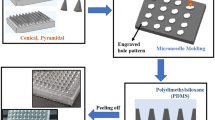Abstract
The key issue in the research of microneedles is how to fabricate microneedles with low cost and good quality. This paper presents a process for fabrication of cone out-of-plane Ni microneedles and characterizes their properties. The fabrication process consisted of inclined rotational MASK and wafer exposure, fine pattern transfer of polydimethylsiloxane (PDMS) and electroplating. The efficiency of transdermal delivery of baicalin, as well as related mechanical properties, are evaluated using rat skin pretreated by a 10 × 10 microneedle array. The fracture strength of the microneedle is 355 MPa. The cumulative permeability rate improves approximately 100 % due to the effect of the microneedle. The method presented in this paper offers the potential for mass production and wide choice of needle material.




Similar content being viewed by others
References
Alfred JH, Scott AK, Diane ES, Noel GH, John AM, Ronald JP (2011) Microneedle-based intradermal delivery enables rapid lymphatic uptake and distribution of protein drugs. Pharm Res 28:107–116
Chang RL, Moon SK, Lee HB, Han KL, John MR, Gilson K (2007) The effect of molecular weight of drugs on transdermal delivery system using microneedle device. Key Eng Mater 342(3):945–948
Chu LY, Choi SO, PrausnitzZ MR (2010) Fabrication of dissolving polymer microneedles for controlled drug encapsulation and delivery: bubble and pedestal microneedle designs. J Pharm Sci 10:4228–4238
Coulman SA, Anstey A, Gateley C, Morrissey A, McLoughlin P, Allender C, Birchall JV (2009) Microneedle mediated delivery of nanoparticles into human skin. Int J Pharm 366:190–200
Donnelly RF, Singh Thakur Raghu Rai, David Woolfson A (2010) Microneedle-based drug delivery systems: microfabrication, drug delivery, and safety. Drug Delivery 4:187–207
Griss P, Stemme G (2003) Side-opened out-of-plane microneedless for microfluidic transdermal liquid transfer. J MEMS 12:296–301
Hadgraft J, Peck J, Williams DG, Pugh WJ, Allan G (1996) Mechanisms of action of skin penetration enhancers/retarders: azone and analogues. Int J Pharm 141:17–25
Han MH, Hyun DH, Park HH, Lee SS, Kim CH, Kim CG (2007) A noble fabrication process or out-of-plane microneedle sheets of biocompatible polymer. J Micromech Microeng 17:1184–1191
Henry S, McAllister DV, Allen MG, Prausnitz MR (1998) Microfabricated microneedles: a novel approach to transdermal drug delivery. J Pharm Sci 87:922–925
Kim K, Lee JB (2007) High aspect ratio tapered hollow metallic microneedles arrays with microfluidic interconnector. Microsyst Technol 13:231–235
Lin LW, Pisano AP (1999) Silicon-processed microneedles. J MEMS 8:78–84
Ling XY (2010) Determination of Baicalin in Niuhuang Qinshao tablets by HPLC. Heilongjiang Medicine 16:886–887
Mcallister DV, Allen MG, Prausnitz MR (2000) Microfabricated microneedles for gene and drug delivery. Annu Rev Biomed Eng 2:289–313
Naik A, Kalia YN, Guy RH (2000) Transdermal drug delivery: overcoming the skin’s barrier function. Pharm Sci Technol Today 3:318–326
Oh JH, Park HH, Do KY, Han M, Hyun DH, Kim CG, Kim CH, Lee SS, Hwang SJ, Shin SC, Cho CW (2008) Influence of the delivery systems using a microneedle array on the permeation of a hydrophilic molecule, calcein. Eur J Pharm Biopharm 69:1040–1045
Park JH, Allen MG, Prausnitz MR (2005) Biodegradable polymer microneedless: fabrication, mechanics and transdermal drug delivery. J Control Release 104:51–66
Prausnitz MR (2004) Microneedles or transdermal drug delivery. Adv Drug Deliv Rev 56:581–587
Prausnitz MR, Langer R (2008) Transdermal drug delivery. Nat Biotechnol 26:1261–1268
Sullivan SP, Koutsonanos DG, Martin MDP, Lee JW, Zarnitsyn V, Choi SO, Murthy N, Compans RW, Skountzou J, Prausnitz MR (2010) Dissolving polymer microneedle patches for influenza vaccination. Nat Med 16:915–920
Wilke N, Mulcah A, Ye SR, Morrissey A (2005) Process optimization and characterization of silicon microneedless fabricated by wet etch technology. Microelec J 36:650–656
Yung KL, Xu Y, Kang CL, Liu H, Tam KF, Ko SM, Kwan FY, Lee TMH (2012) Sharp tipped plastic hollow microneedle array by microinjection moulding. J Micromech Microeng 22:1–10
Zhou CP, Liu YL, Wang HL, Zhang PX, Zhang JL (2010) Transdermal delivery of insulin using microneedle rollers in vivo. Int J Pharm 392:127–133
Acknowledgments
This research is supported by the Cultivating Foundation for Innovation Engineering Program of the Ministry of Education of China under grant (708037), the Chinese National Natural Science Foundation (50775149 and 60976081).
Author information
Authors and Affiliations
Corresponding author
Rights and permissions
About this article
Cite this article
Zhu, J., Shen, Q., Cao, Y. et al. Characterization of out-of-plane cone metal microneedles and the function of transdermal delivery. Microsyst Technol 19, 617–621 (2013). https://doi.org/10.1007/s00542-012-1672-0
Received:
Accepted:
Published:
Issue Date:
DOI: https://doi.org/10.1007/s00542-012-1672-0




